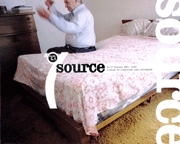Upside-down and Playing Backwards
KAYAKÖV by Dutton and Peacock was at Catalyst Arts, Belfast, March 2001
Review by Siún Hanrahan
Issue 27 Summer 2001
View Contents ▸
I found Steve Dutton and Percy Peacock's exhibition KAYAKÖY at Catayst Arts in Belfast compelling and disconcerting.
It was compelling in that its combination of photographs, video works and text (a collaborative production by Steve Dutton and artist/writer Steve Swindells) was intriguing and coherent. Disconcerting because of the stark contrast between two sets of photographs within the exhibition (in terms of subject matter, colour and format), and because the two video works were wilfully bewildering. (In one the picture is upside-down, plays backwards and the video-recorder swings gently from side-to-side, while in the other junk accumulates and is disposed of for no apparent reason).
Of the nine photographs comprising this exhibition, five featured distinctly modern, industrial/office-like spaces, were circular in format and rotated slowly (some clockwise, some counter-clockwise). Three others featured an old-style painting, a portrait of a single figure, done in dark browns and ochres with a rectangular format. The spaces represented in the 'modern' images were Largely empty. Each has one central feature (a stack of boxes, a stand with optical equipment such as a slide projector, etc.) set on a smooth concrete floor against a white chipboard wall. Two of the 'art-historical' images reproduce the sombre portrait of a slightly disgruntled looking woman in three-quarter profile and are hung side-by-side and upside down. The third represents what seems to be the same portrait in a heavy gilt frame but Lit in such a way that the image cannot be made out other than through the texture of the paint.
Beyond their abrupt difference it seemed to me that some continuity could be discerned between these opposed sets of photographs. Both present detritus, things rendered useless through irrelevance. Within one of the modern' photographs, for example, a low mound of junk - insulating felt, plaster, dust and grit - is clustered under a lit anglepoise light and spills from the table onto the floor, scattering towards the viewer. Even where the items recorded are neatly stacked their isolation within distinctly empty space casts them as abandoned, robbed of purpose or meaningful relationship. Within the 'art historical' photographs the significance of the sitter is undermined by the doubling and inversion of her portrait, reminding me of rooms and corridors lined with darkly glazed portraits of people whose irrelevance to those passing through the space obliterates distinction. Even where an attempt has been made to highlight and focus attention on this portrait, there is nothing to be seen beyond a dimly discernible outline. Mary
Mary
And yet these photographs do not quite document 'detritus'. The rotation of the 'modern' images curtailed my wondering about the nature of the spaces featured and rendered the photographs as 'almost abstract', d matter of surface and pattern, colour and composition. While the 'art historical' images seemed to achieve a similar effect through their refusal of relationship - to the sitter through doubling and invisibility, between their space and ours through inversion and exclusion. Seen as a matter of colour and composition, the cool weightlessness of the circular images was complemented by the burnished gravitas of the others.
The video works continue the photographs 'play with detritus and the site of meaning. Both feature rubbish - a fast-food meal and all its packaging in one (played backwards) and all sorts of rubble and junk in the other. In the Latter, the video recorder is placed at the edge of a long table (possibly that featured in two of the 'modern' photographs) behind which is a blackboard with sharply drawn angled lines and cloudy tracks of chalk reminiscent of the smoke trail of fireworks. The camera might almost have been left running unintentionally as debris is thrown onto and scrapped off the table. And yet there are moments where this 'activity' is clearly staged. When, for example, a 'prop' (a Lumpy pat of resin) is slid into the lower left corner of the screen as though it had been forgotten and might be slipped in unnoticed. Or when, after the introduction of an item such as the white-fringed red velvet cloth from one of the photographs or a large sheet of blue plastic, everything stops for a moment of appreciation of this new effect - a photo opportunity.
So what is being staged? I thought perhaps meaninglessness. An endless adding and taking away toward no particular end. A realisation that, as Robert Smithson said, "without gods and destiny we are constantly under the threat that nothing is happening". And yet I believe that the work offers an invitation to continue to create patterns and locate beauty. The first and Last piece encountered within the exhibition was a rotating image of a sunny glade and a cyclical story that seemed to echo through this 'theatre'. Endless stories might be enacted in "a chain of copses splashed, green..." The compelling and disconcerting invitation, as Gianni Vattimo suggests, is "to know that one is dreaming and yet to continue dreaming".
Other articles by Siún Hanrahan:






